Lab Grwon Diamonds
Lab grown diamonds are identical to their natural counterparts and can be a more affordable option. We are committed to going beyond industry standards to offer lab grown diamonds that are ethical and sustainable.

Origin
Our Lab Grown Diamonds are sourced from first world countries as they are created and cut in a controlled lab environment.
Environmental Impact
No Environmental impact, because lab grown diamonds are made in a controlled lab environment.
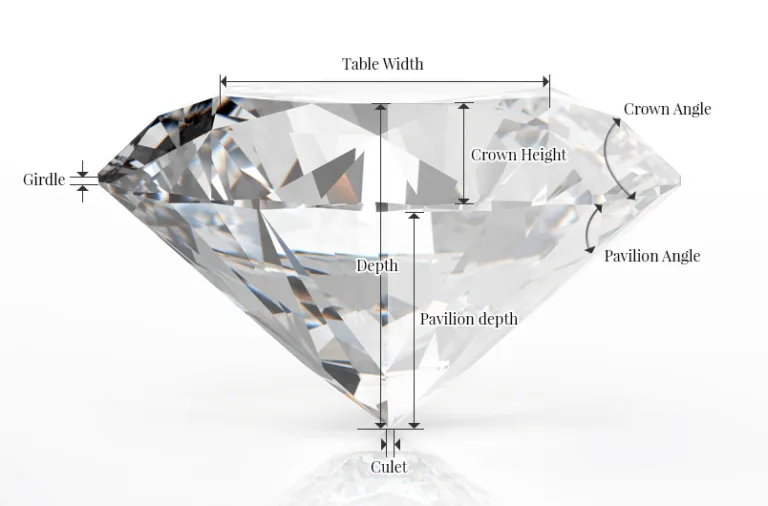
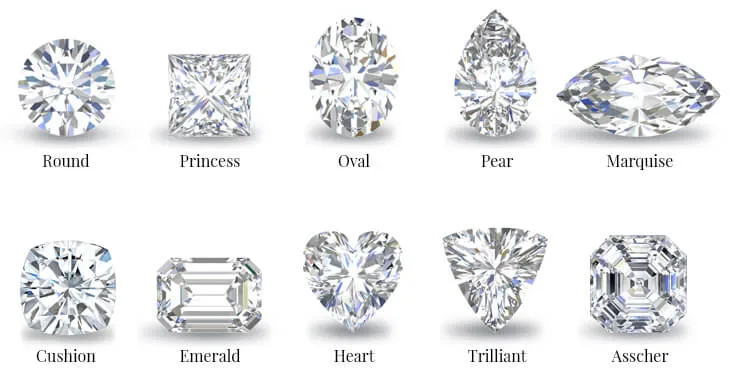
Shapes
Round: A circular shaped diamond, the most popular and classic brilliant cut.
Princess: Traditionally square and angular version of round cut with four pointed corners.
Oval: An elliptical shaped diamond which is modified version of round cut.
Pear: A Teardrop silhouette diamond with one side pointed end and the other side with rounded end.
Marquise: A striking elongated shaped diamond with curve sides and two pointed end.
Cushion: A pillow cut diamond, usually square or rectangular with curvy sides and rounded corners.
Emerald: An elongated rectangle diamond with step cut on sides and a large flat top with cropped corners.
Heart: The most romantic diamond and the perfect symbol of love.
Trilliant: A triangular shaped diamonds with three equal sides curvy or straight and three pointed corners.
Asscher: A square shaped diamond with step cut sides and cropped corners.
Cut
A Diamondu2019s beauty lies in its complex relationship with light and how it strikes the surface, enters the diamonds, then reflect back its brilliance. This magnificent display comprises of three attributes
Brightness, a combination of all white light reflecting from the surface and interior of the diamond.
Fire, the flares of color emitting from diamond.
Scintillation, flashes of light appears when the diamond, the light or the observer moves.
A diamondu2019s proportions affect its light performance and appeal. Diamonds with ideal proportions, symmetry and polish enhances and influences its brightness, fire, scintillation and the overall brilliance of the diamond.
It is expressed on a scale from
Excellent – Very Good – Good – Fair – Poor
Too Shallow Cut: Light escaped from the sides, causing the diamond to lose brilliance and creates a dull opaque and glassy look.
Ideal Cut/ Excellent Cut: Perfect proportions captures all the light and reflects back with fire and brilliance.
Too Deep Cut: Light escapes from the bottom causing the diamond to appear dull and when viewed from above appears darker and lifeless in the center.

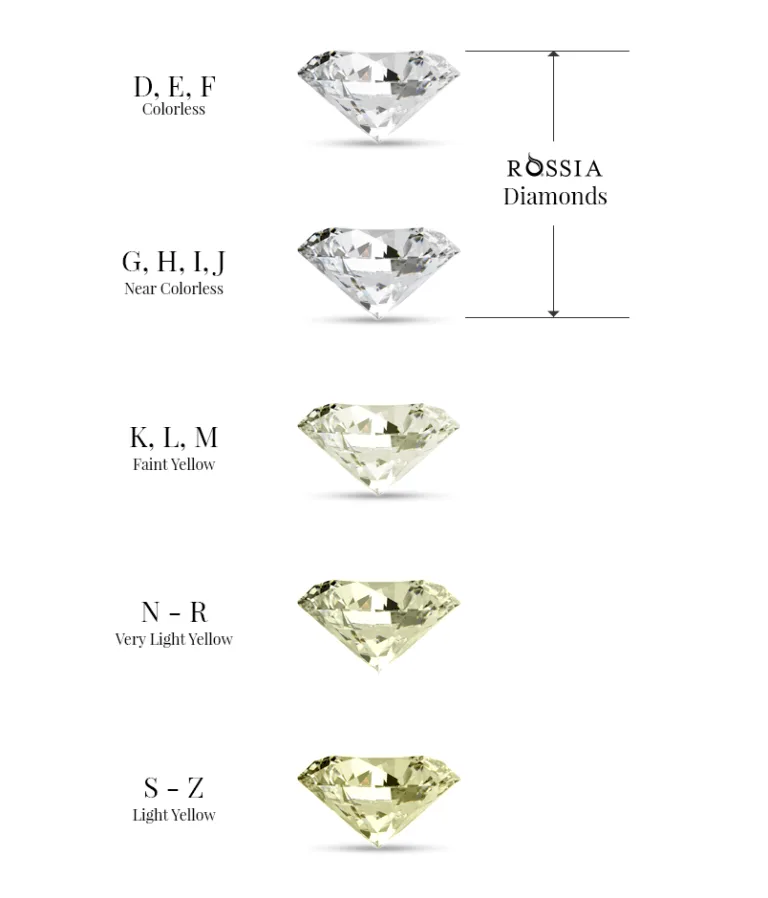
Color
Diamonds have been found in many hues and shades over the years. Grading a diamond´s color means categorizing the smallest differences in color shades.
A diamond’s price is determined on the basis of its color; the less color, the more rare and more expensive is the diamond. A diamond is graded on an alphabetical scale, the highest color grade is D (white/transparent) and the lowest Z (yellow).
At Rossia, we prefer colorless to nearly colorless diamonds like D, E, F, G, H, I, and J, which are most popularly used in Jewellery. We do fancy color diamonds on request only.
Fluorescence
Fluorescence is an optical phenomenon that makes diamonds emit visible light (usually blue) when exposed to ultraviolet light. Some diamonds can emit a visible light when exposed to ultraviolet radiation. However, in gemology fluorescence is not a quality feature, nor a factor in determining color or clarity grading, but rather a characteristic for identification. That’s why it is stated in every gemological certificate.
Influence on price
Fluorescence can influence a diamond’s price as well as its appearance; hence, these diamonds are usually sold on a discount, as the market considers it as disadvantageous which is expressed in price.
As the diamonds with extremely strong fluorescence can cause the stone to appear hazy, high color grades from D-G are discounted up to 10-15%.
The intensity of the emitted visible light is graded as per the following grading
Terms:
None: The diamond shows no fluorescence
Faint: UV light makes the diamond show a slight blueish shade
Medium: The diamond emits visible light when exposed to ultraviolet light
Strong: The reaction to UV Light is clearly visible
Very Strong: The diamond glows in an intense blue color when exposed to UV light
Clarity
Diamonds are formed under tremendous heat and pressure, because of fthis- it is extremely rare to find a diamond that lacks any internal or external imperfections. These characteristics are a by-product o its formation and helps identifying individual stones. All the diamonds are graded on the basis of 2 characteristics:
Inclusions, that are inside the diamond
Blemishes, which are surface defects of the diamond.
At Rossia, We prefer to use FL, IF, VVS, VS, and SI clarity diamonds.
FL – Flawless; No Internal Or External Inclusions
No Inclusions Or Blemishes.
IF – Internally Flawless: No Internal Inclusion
Loupe- Clean. No Inclusions visible.
VVS1, VVS2 – Very Very Slightly Included
Minute imperfections, very difficult to see.
VS1, VS2 – Very Slightly Included
Minor imperfections visible under loupe
SI1, SI2 – Slightly Included
Infections are easily spotted under loupe
I1, I2, I3 – Included; Inclusions Are Clearly Visible To The Naked Eye.
Clearly visible through naked eye.
(These are not used at Rossia and are available only on request.)


Carat
Carat (CTS) is a standard term for weighing Diamond and other Precious Gemstones, however, it does not necessarily reflect a diamond´s size. Diamond prices increase exponentially with Carat Weight and is highly influenced by its shape, cut, color and clarity.
1 Carat = 200 Milligrams
1 Carat = 100 points.
Less than 1 Carat weight diamonds are referred as points (like 0.75 points, 0.50 points, 0.25 points)
While one diamond has a bigger diameter and appears larger looking from above, the other retains most of its weight in the pavilion, the lower part of the stone, and therefore seems smaller even though they both have the same weight.
The higher the carat weight, the higher the value. But, a smaller diamond with ideal cut proportions is always a better choice, whatever the carat weight.
Certificate
Often called the 5th C, a diamond certificate is a diamond grading report created by a team of gemologists. A detailed report specifying the analysis of the diamond’s 4C’s- Cut, Color, Clarity and Carat along with dimensions and other characteristics
A Diamond Certificate is an indispensable tool that helps you evaluate and choose your diamond with confidence and convenience. The Report Number, which is a unique series of digits for identification purposes is laser inscribed on the girdle of the diamond and is also retained by most labs.
Its easily accessible by this number in their database, in case you misplace your report and need a replacement.
More importantly, this number also allows you to have a direct verification of the document via the gemological lab’s website.
Solitiare Diamond Certificate by:
GIA – Gemological Institute of America
IGI – International Gemological Institute
Jewellery Certificate by:
IGI – International Gemological Institute
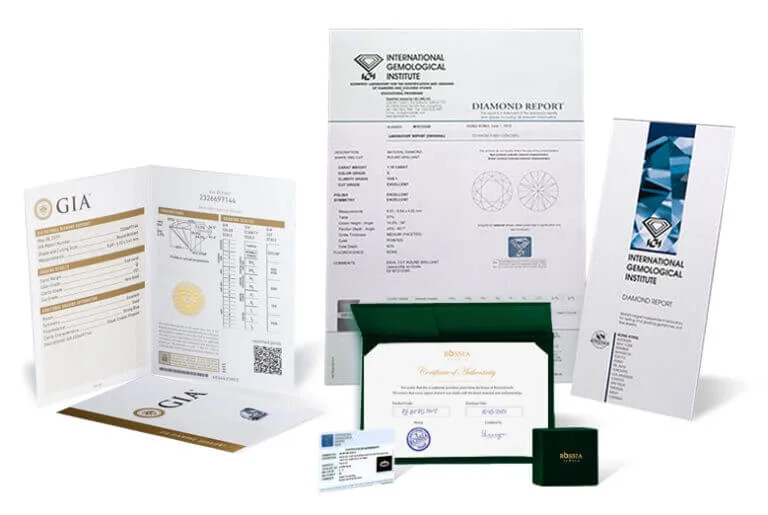
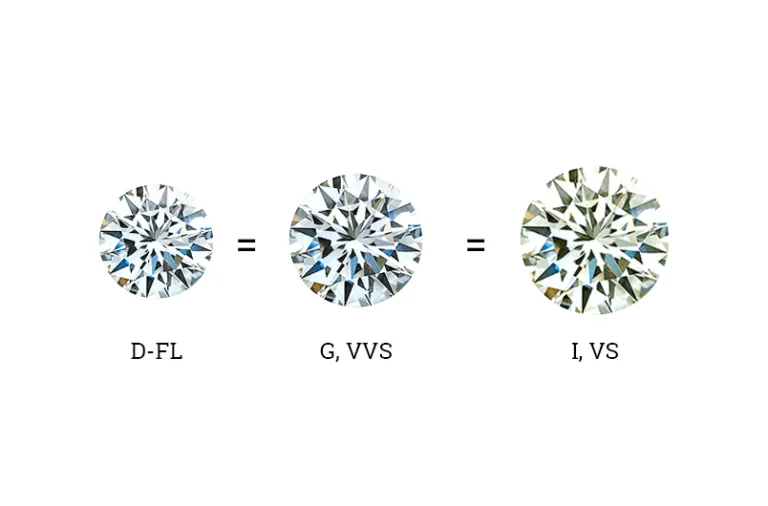
Perfect Price
The price of diamonds is determined by the rarity of its occurrence. Since, no two diamonds are alike and may look the same to the naked eye, it under 10x magnification one would have more inclusions and blemishes than the other.
A smaller diamond with D-F color and FL-IF clarity will cost approximately equal to a larger diamond with H-J color and VS1-SI2 clarity.
A diamond of D-F color with FL-IF clarity is rare, and makes it more expensive than H-J color with VS-SI clarity. Though both diamonds will look equally beautiful.
The best way to buy diamonds at the perfect price, is to select what suits you the best with an all-rounder characteristics and balance of color, clarity and carat but never compromise on the cut of the diamond.
At Rossia, we believe in crafting one-of-a-kind rings and with a perfect diamond for you.
Conflict Free
All diamonds at Rossia, are purchased from legitimate sources and are not involved in funding conflict. We deal with trusted and reputable suppliers, who guarantee their diamonds are conflict-free.




